Ancient Greek Religion › Temple » Ancient origins
Articles and Definitions › Contents
- Ancient Greek Religion › Antique Origins
- Temple › Ancient History
Ancient civilizations › Historical and archaeological sites
Ancient Greek Religion › Antique Origins
Definition and Origins
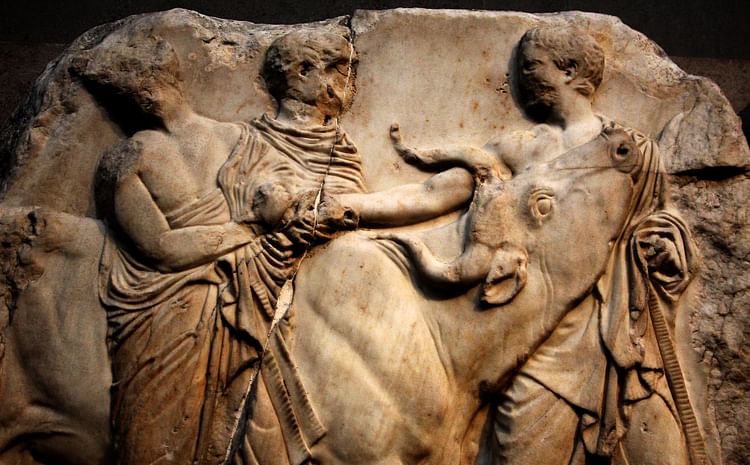
In the ancient Greek world, religion was personal, direct, and present in all areas of life. With formal rituals which included animal sacrifices and libations, myths to explain the origins of mankind and give the gods a human face, temples which dominated the urban landscape, city festivals and national sporting and artistic competitions, religion was never far from the mind of an ancient Greek. Whilst the individual may have made up their own mind on the degree of their religious belief and some may have been completely sceptical, certain fundamentals must have been sufficiently widespread in order for Greek government and society to function: the gods existed, they could influence human affairs, and they welcomed and responded to acts of piety and worship.
THE OLYMPIAN GODS
Polytheistic Greek religion encompassed a myriad of gods, each representing a certain facet of the human condition, and even abstract ideas such as justice and wisdom could have their own personification. The most important gods, though, were the Olympian gods led by Zeus :
- Zeus
- Athena
- Apollo
- Poseidon
- Hermes
- Hera
- Aphrodite
- Demeter
- Ares
- Artemis
- Hades
- Hephaistos
- Dionysos
These Olympian gods were believed to reside on Mt. Olympos and would have been recognised across Greece, albeit, with some local variations and perhaps particular attributes and associations.
IN THE GREEK IMAGINATION, LITERATURE & ART, THE GODS WERE GIVEN HUMAN BODIES & CHARACTERS - BOTH GOOD & BAD.
In the Greek imagination, literature, and art, the gods were given human bodies and characters - both good and bad - and just as ordinary men and women, they married, had children (often through illicit affairs), fought, and in the stories of Greek mythology they directly intervened in human affairs. These traditions were first recounted only orally as there was no sacred text in Greek religion and later, attempts were made to put in writing this oral tradition, notably by Hesiod in his Theogonyand more indirectly in the works of Homer.
TEMPLES, RITUALS & PRIESTS
Gods became patrons of cities, for example, Aphrodite for Corinth and Helios for Rhodes, and were called upon for help in particular situations, for example, Ares during war and Hera for weddings. Some gods were imported from abroad, for example, Adonis, and incorporated into the Greek pantheon whilst rivers and springs could take on a very localised personified form such as the nymphs.
The temple ( naos - meaning dwelling place in reference to the belief that the god dwelt in that place, or at least temporarily visited during rituals) was the place where, on special occasions, religion took on a more formal tone. Gods were worshipped at sacred sites and temples in all major Greek communities in ceremonies carried out by priests and their attendants.
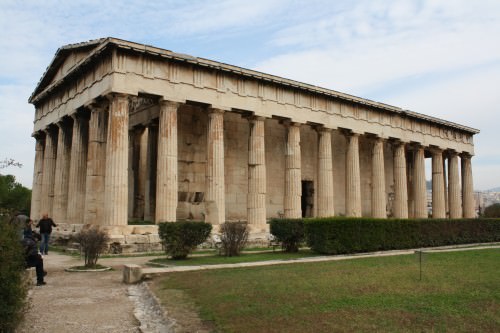
Temple of Hephaistos & Athena, Athens
At first, sacred sites were merely a simple altar in a designated area, but over time massive temples came to be built in honour of a particular god and these usually housed a cult statue of the deity, most famously the huge statue of Athena in the Parthenon of Athens or Zeus at Olympia. In time, a whole complex of temples to lesser gods could spring up around the main temple, creating a large sacred complex, often built on an acropolis dominating a city or surrounding area. This sacred area ( temenos ) was separated from the rest of the community by a symbolic gate or propylon, and in fact, it was believed that this area belonged to the particular deity in question. Sacred sites also received financial donations and dedications of statues, fountains and even buildings from the faithful, often to celebrate a great military victory and give thanks to the gods, and larger sanctuaries also had permanent caretakers ( neokoroi ) who were responsible for the upkeep of the site.
THE ANIMALS SACRIFICED WERE USUALLY PIGS, SHEEP, GOATS OR COWS & ALWAYS THE SAME SEX AS THE GOD WHICH WAS BEING HONOURED.
The temple itself, though, was not used during religious practices as these were carried out at a designated altar outside the temple. Ancient authors often show a reluctance to go into explicit details of religious ceremonies and rites as if these were too sacred to be publicised in the written word. What we do know is that the most common religious practices were sacrifice and the pouring of libations, all to the accompaniment of prayers in honour of the god. The animals sacrificed were usually pigs, sheep, goats or cows and always the same sex as the god which was being honoured. The meat was then either burnt completely or cooked, with part offered to the god and the rest eaten by some or all of the worshippers or taken away to be eaten later. The actual killing of the animal was carried out by a butcher or cook ( megeiras ) whilst a young girl sprinkled seeds onto the animals head, perhaps symbolic of life and regeneration at the moment of the animal's death. Other such rituals included examining the entrails of sacrificed animals to ascertain signs which could help predict future events.
Priests then, orchestrated the religious ceremonies and delivered prayers. The position was generally open to all and once assuming the role, particularly when wearing the sacred headband, the body of the priest became inviolate. Priests served a specific god but they were not necessarily religious experts. For theological questions, a citizen could consult an exegetes, a state official, who was knowledgeable in religious affairs. Women could also be priests, which is perhaps surprising given their lack of any other public role in Greek society. Often, but not always, the priest was the same sex as the god they represented.Priestesses did have the added restriction that they were most often selected because they were virgins or beyond menopause. Worshippers, on the other hand, could be both sexes and those rituals with restrictions could exclude either men or women.

Demeter
MYSTERIES & ORACLES
In addition to the formal and public religious ceremonies there were also many rites which were open to and known only by the initiated who performed them, the most famous example being the Mysteries of Eleusis. In these closed groups, members believed that certain activities gave spiritual benefits, amongst them a better after-life.
Places could also acquire a divine connection; the great oracles such as that of Apollo at Delphi and Zeus at Dodona may well have begun as places considered particularly good to receive signs from the gods. Such places became hugely important centres with their priest oracles consulted by both individuals and city-states so that the rather vague and ambiguous proclamations might help guide their future conduct.
FESTIVALS & GAMES
Athletic Games and competitions in music (especially playing the kithara and lyre ) and theatre (both tragedy and comedy) were held during festivals such as the City Dionysia of Athens and the Panhellenic games at the most important sacred sites of Olympia, Delphi, Nemea, and Isthmia to honour a particular god. These events were attended by visitors from all over Greece and the experience was perhaps more akin to a pilgrimage rather than that of a mere sports fan. Illustrating their sacred status, warfare was prohibited during these events and pilgrims were guaranteed free-passage across Greece.However, there were also much smaller festivals, sometimes only attended by a very select number of individuals, for example, the Arrhephoria in Athens, where only priestesses and a maximum of four young girls participated.
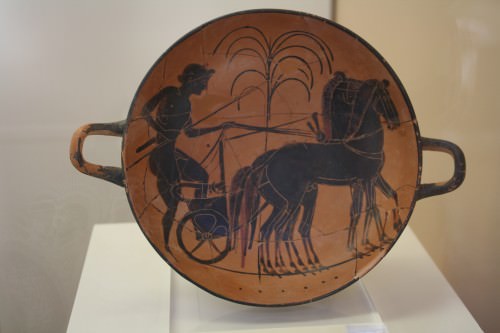
Greek Chariot
PERSONAL RELIGION
Although the historical record reveals much about formal religious occasions and ceremony, we should remember that Greek religion was in fact practised anywhere, at any time, by private individuals in a very personal way. Not only temples but also the hearth in private homes was regarded as sacred, for example. Individuals could also visit a temple anytime they wanted to and it was customary to say a prayer even when just passing them in the street. People left offerings such as incense, flowers, and food, no doubt with a hopeful prayer or in gratitude for a past deed. Individuals could also organise their own private sacrifice if they had the means to do so, and these have been commemorated in thousands of stone relief markers found at sacred sites. In addition, temples were often visited in order to seek healing, especially at those sites associated with Asclepius the god of medicine, notably at Epidaurus.
People also looked for signs from the gods in everyday life and to interpret these signs as indicators of future events. Such signs could be birds in the sky or a spoken word between friends said at a particular moment or even a simple sneeze which might be interpreted as an auspicious or inauspicious omen.
Such beliefs and, indeed, certain aspects of religion such as the immorality of the gods as portrayed in the arts, were severely criticised by intellectuals, artists, and philosophers from the 5th century BCE, but these may or may not reflect the commonly held views of the wider populace, and it is difficult to believe from the wealth of archaeological and written records that religion was anything but a fundamental part of life for the ordinary inhabitants of the ancient Greek world.
Temple › Ancient History
Definition and Origins
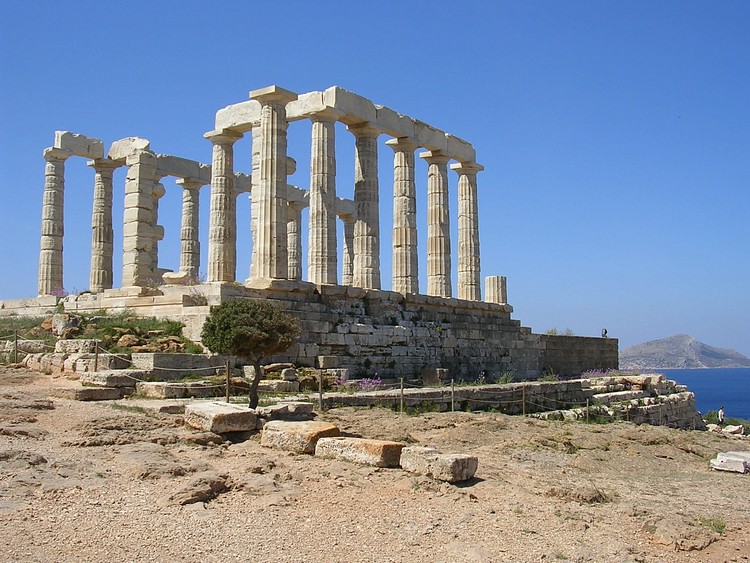
A temple (from the Latin 'templum') is a structure usually built for the purpose of, and always dedicated to, religious or spiritual activities including prayer, meditation, sacrifice and worship. The templum was a sacred precinct defined by a priest (or augur) as the dwelling place of a god or gods and the structure built there was created to honor the Deus Loci (spirit) of a certain place. Early temples were constructed on sites which the people felt had a numinous quality to them which indicated the presence of a god, gods, or spirits. Some the earliest examples of these outdoor temples still extant are in Orkney, Scotlandat sites such as the Ness of Brodgar. Throughout the United Kingdom, the stone circles and structures from the Neolitic Period are all known to have once been used for religious ceremonies whether on a large scale, such as at Brodgar or more modest sites like the one at Clava Cairns. The Mayan temples are also thought to have begun as modest outdoor sites before the rise of the great pyramid temples such as El Castillo at Chichen-Itza. The word 'temple' dates to around the 6th century BCE in reference to Roman places of worship.
GOBEKLI TEPE TEMPLE
The oldest known temple is that at Göbekli Tepe in southeastern Turkey which is 11,500 years old and is decorated with reliefs and pictograms of various plants and animals thought to represent the gods of that place. The temple is an extraordinary building of the Neolithic era with T-shaped pillars and engravings which have yet to be completely understood. The design of the temple, however, with a large room toward the front (possibly for public functions) is recognized in later temples from other cultures. The Gobekli Tepe Temple's stone carvings of plants and animals suggest an animistic focus of the belief structure of those who built the site. Animism is the early religious belief that everything on earth, whether animate or inanimate, possessed a soul or intelligence which needed to be recognized and respected. This belief was shared by the Native Americans of North America, the Maya, in the Chinese belief system of Taoism and the Japanese religion of Shintoism among others. The Egyptians, to name another example, held that all of life was sacred.
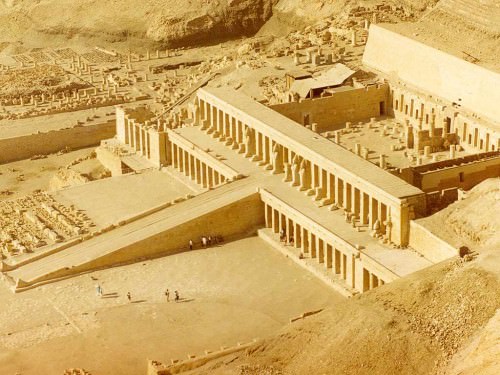
Temple of Hatshepsut
TEMPLES IN ANCIENT EGYPT
In the religious customs of ancient Egypt the temple was considered 'the horizon' of a divine being, the point at which the god came into existence at creation, and thus every sacred site had a link to the very distant past and honored the specific god whose temple it was. The temple also was a mirror of the universe and a representation of the ben-ben, the sacred mound which rose out of chaos by the will of Amon at the beginning of time. As in ancient Mesopotamia, the temple in Egypt was considered the literal home of the god to whom it was dedicated. Hathor 's temple at Dendera, then, was considered her actual house and the priests and priestesses of Hathor cared for the goddess as they would a living person of flesh and blood.Every Egyptian temple followed the same basic design (thought to have been decreed by the gods themselves) of a forecourt and reception area for public gatherings with colonnades and inclines rising higher and higher to smaller and even smaller rooms until one reached the room of the Holy of Holies where the god was thought to reside when visiting earth. Only the high priest of the god of the temple could enter the Holy of Holies and commune with the deity there.
MESOPOTAMIAN TEMPLES
Ancient Mesopotamian temples fulfilled many roles. Not only were they the house of the local deity or the patron god of the city, they were also the administrative centers of the first cities in Sumer. The city of Eridu was considered the first city in the world by the Sumerians, created by the gods after their victory of order over the forces of chaos. The origin of the decrees of civilization (the sacred meh ) were thought to come from the temple there where the god of wisdom, Enki, lived. The goddess Inanna stole the meh from Enki after a drunken party and brought them to Uruk, considered by scholars the first city in the world and once one of the largest and most prosperous. The story of Inanna bringing the meh from Eridu to Uruk is thought to symbolize the transference of power from the one city to the other and, specifically, from one temple, one sacred spot, to another. Uruk was initially ruled by a priest-king, and it is believed that many early Mesopotamian cities followed the same model, where the temple was the seat of both religious and secular authority. Even after the rise of secular kings, however, the temple was the central structure of every city throughout Mesopotamia serving as a seat of kingship, of administration, and organizing the distribution of food among the people.
THE TEMPLE IN JUDAISM
In Judaism, the original ancient Hebrew language refers not to a 'temple' but to a "sanctuary", "palace" or "hall". Each of the two ancient temples in Jerusalem were called Beit Hamikdash, which translates literally as "the Holy House" and, in this, the Hebrews either copied or independently arrived at the same conception of a temple that the ancient Egyptians had: that the temple was the house of the god. The Temple Mount in Jerusalem is the site where the First Temple of Solomon and the Second Temple were built. and at the center of the temple was the Holy of Holies, where, as in Egypt, only the high priest could enter. The Greek word synagogue came to describe Jewish places of worship during the Babylonian Captivity and meant 'to gather together'. The original Hebrew words Bet Knesset ("House of Meeting") and synagogue designate Jewish temples today.

Temple of Hera, Selinus
ANCIENT GREEK TEMPLES
Most Greek religious buildings in the modern day are referred to as "temples," but the Greek pagans (known only as 'pagans' after the rise of Christianity ) would have called a holy place a temenos, or sacred precinct. The sacredness of the place had entirely to do with the spirit of the god who resided there, not with whatever building was later constructed on the spot, as in the case of the Temple of Demeter at Eleusis, the Temple of Artemis at Ephesus or the famous Parthenon of Athens which housed the statue of Athena Parthenos (Athena the Virgin, patron goddess of the city). The building which housed the statue, then, was sacred owing to the original presence there of, or some great deed done by, the god of that place. The Temple of Aphaia, on the island of Aegina, is only one example of the temple as home of the deity of the place. The goddess Aphaia was thought to live in the temple to personally care for the people of the island.
TEMPLES IN CHINA & INDIA
In China, early temples honored Xi'an (heaven) which represented both creation and divine order. Xi'an was the equivalent of the concept of an all-powerful deity but also heaven and the glorious home of the ancestors. Not every temple in China honored a deity, however. The Confucian Temple in the city of Qufu honors the philosopher Confucius. Built in his hometown in 478 BCE, the temple is thought to channel peace and tranquility but makes no claim to house a deity. This is also true of Shinto temples in Japan which are always constructed in accordance with the spirits of the area and their wishes but not dedicated to, nor home of, any one particular god. The Shinto temples and shrines share a common feature with those in India where the altars are usually adorned with pictures or statues of the god or gods honored there. The significant difference is that Shinto temples honor the spirits of the place while Hindu temples revere gods, though the gods worshipped and honored are in some way associated with the area of the temple. The interior of temples throughout India, with few exceptions, follows the basic form and structure of the temple at Gobekli Tepe which, as noted earlier, has served as the underlying paradigm for temples around the world no matter what form their facade takes.
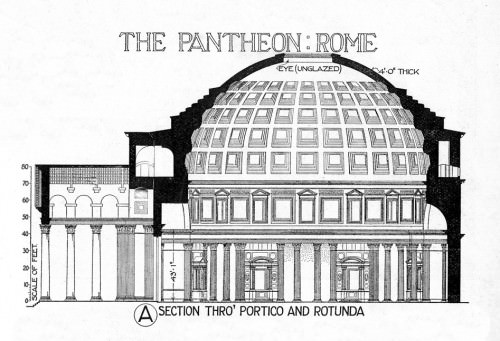
The Pantheon, Rome
ROMAN TEMPLES
In ancient Rome the rituals that located and sited the temple were performed by a high priest, an augur, who, through the observation of the flight of birds or other natural phenomena, understood the loci of the god. Roman temples usually faced east or toward the rising sun, though a notable exception is the great Pantheon which faces north (only preserved after the rise of Christianity because it was made into a church instead of being destroyed and built over, which was the fate of most 'pagan' temples). In ancient Rome, only the deities of the Roman pantheon had a templum; any building honoring a foreign deity was called a fanum. Visitors to Rome were welcome to worship at the fanum of their native gods but were required to worship the gods of Rome in the temples. After the rise of Christianity the word 'temple', with its pagan connotations, was rejected by most Christian congregations in favor of designations such as 'church' or 'cathedral', though the word is still used by the Eastern Orthodox Church to refer to their places of worship.
LICENSE:
Article based on information obtained from these sources:with permission from the Website Ancient History Encyclopedia
Content is available under License Creative Commons: Attribution-NonCommercial-ShareAlike 3.0 Unported. CC-BY-NC-SA License